
38 year old female patient before and 6 months after bilateral breast lift with implants (310cc round saline implants). She only has a periareolar scar. Notice the asymmetry before and after surgery. She not only wanted a lift but to also increase her size from A --> C, which is why she required breast implants. She is much more confident and now feels good about herself.
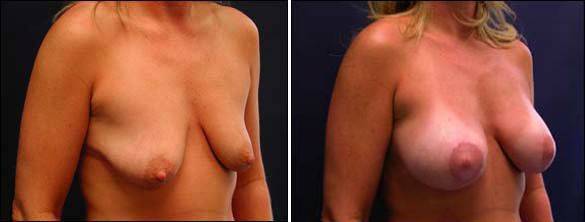
38 year old female patient before and 6 months after bilateral breast lift with implants (310cc round saline implants). She only has a periareolar scar. Notice the pleasing contour.
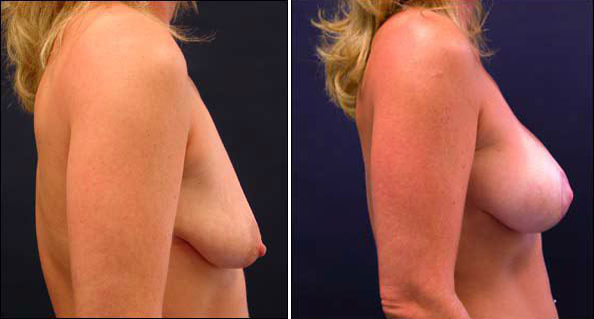
38 year old female patient before and 6 months after bilateral breast lift with implants (310cc round saline implants). She only has a periareolar scar. Notice the great projection.
38 year old female patient before and 6 months after bilateral breast lift with implants (500cc round saline implants). She only has a periareolar scar. She not only wanted a lift but to also increase her size from B --> D, which is why she requested breast implants. She only had breast implants without the scarring of a breast lift or mastopexy. The reason for this is because she had a newer procedure that Dr. Speron is performing -- internal breast lift with no external sutures! Notice the correction of her asymmetry.
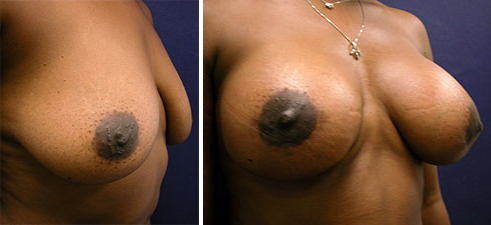
38 year old female patient before and 6 months after bilateral breast lift with implants ( 500cc round saline implants). She only had breast implants without the scarring of a breast lift or mastopexy. The reason for this is because she had a newer procedure that Dr. Speron is performing -- internal breast lift with no external sutures! Notice the upper pole fullness.
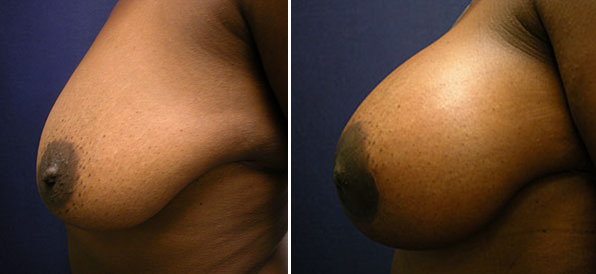
38 year old female patient before and 6 months after bilateral breast lift with implants (500cc round saline implants). She only had breast implants without the scarring of a breast lift or mastopexy. The reason for this is because she had a newer procedure that Dr. Speron is performing -- internal breast lift with no external sutures! Notice the improved shape.
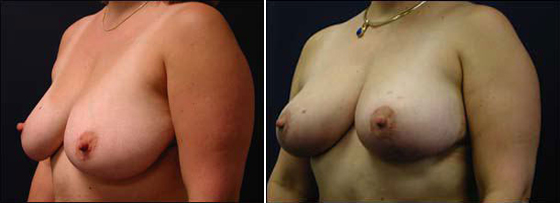
37 year old female patient before and 1 years after vertical breast lift without a change in cup size. Notice the maintained upper breast fullness. There are no horizontal scars.
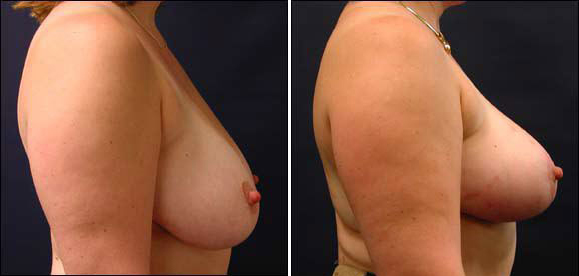
37 year old female patient before and 1 years after vertical breast lift without a change in cup size. Notice the much improved projection.

35 year old female patient before and 6 months after bilateral short scar vertical breast lift. Notice the improved symmetry - she is still off by a few mms in a few spots but that doesn't bother her. She was very happy with the lifting, and also wanted a slightly smaller size which we were able to do at the same time. This is an average result.
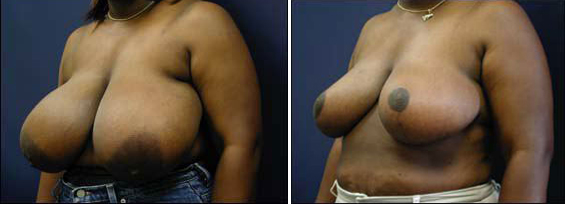
32 year old female patient before and 2 years after breast lift with breast reduction (42F --> 42C). Patient not only wanted a lifting of her breasts but also a reduction in their size. Notice the much improved shape.
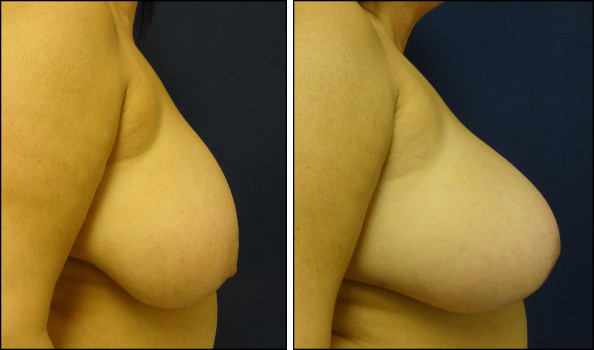
48 year old female patient before and 3 years after vertical or short scar breast lift. Notice the continued improved lift & projection. This is because this surgery takes away the lowest hanging skin and pushes both pillars together to get a much better lift than the older inverted T approach. This surgery takes 1-2 hours and the patient has no drains or outside stitches.
The Chicago Breast Enhancement & Lifting Scars:
Anytime a human being gets cut (with surgery or trauma), scars heal the following way: Initially they are red, raised and hard. Within 6-12 months, they are flat, white and soft. Younger people (<18 years old) have scars that might stay active or red for up to 2 years. Older people (>65 years old) have scars that might stay active or red for less than 3 months.
Periareolar Scars

58 year old before and 3 months after breast periareolar lift. Notice the close-up of the areolar scar puckering which usually flattens over time. The puckering is from using a shorter scar but removing a lot more skin and closing it down to the smaller scar. The redraping and flattening occurs over time with manual massaging. The risk of needing a scar revision because this doesn’t fully resolve is <3%.
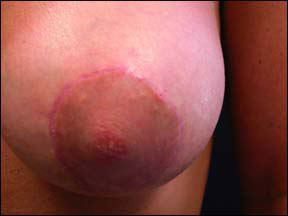
6 weeks after surgery
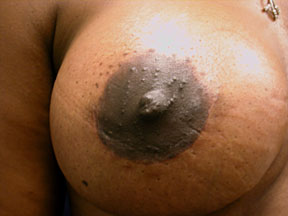
3 months after surgery
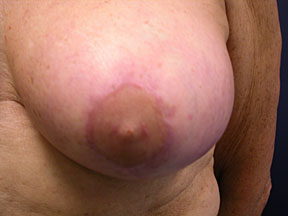
4 months after surgery
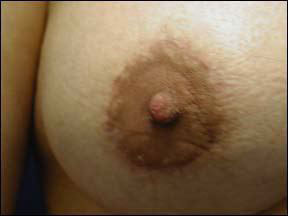
6 months after surgery
Vertical Scars (NO horizontal scars!) - this is the approach I use in about 90% of my patients needing a breast lift.
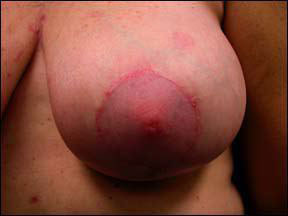
6 weeks after surgery
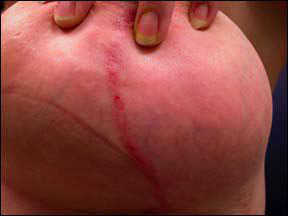
6 weeks after surgery
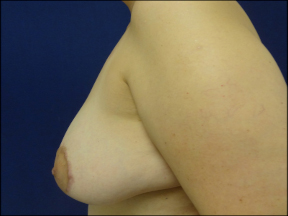
8 weeks after surgery
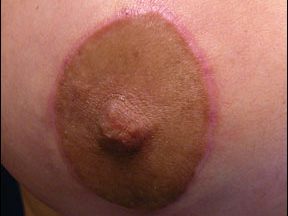
3 months after surgery
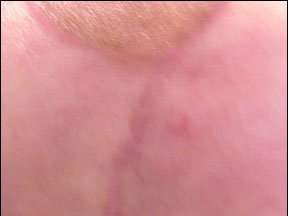
3 months after surgery
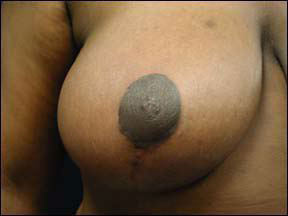
6 months after surgery
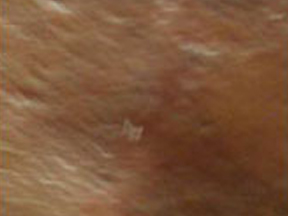
6 months after surgery
Inverted T Scars
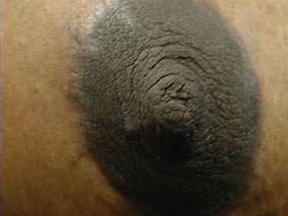
6 weeks after surgery
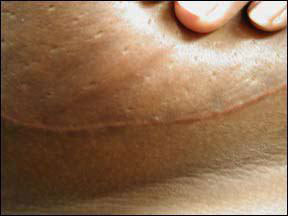
6 weeks after surgery
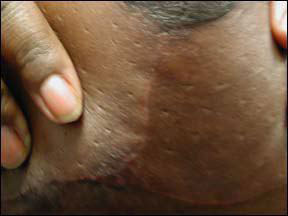
6 weeks after surgery
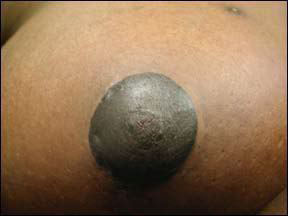
1 year after surgery
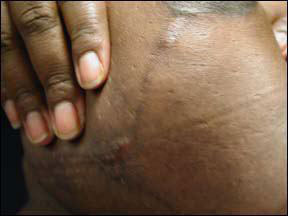
1 year after surgery
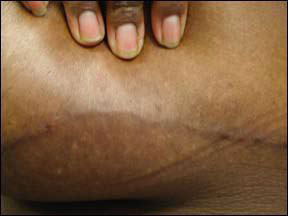
1 year after surgery
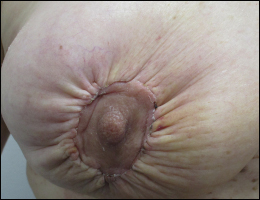
53 year old female 1 day postoperative from an periareolar lift. Patient had a lot of droopiness and needed a short scar vertical breast lift but did not want the additional scarring. The areolar lift gave her nice projection with a minimal scar. All the puckering is expected initially and usually flattens out within a few weeks. The more skin removed, the more puckering after surgery. Here there’s a lot of puckering because a lot of skin was removed so it might take up to 3 months for it to fully go away.
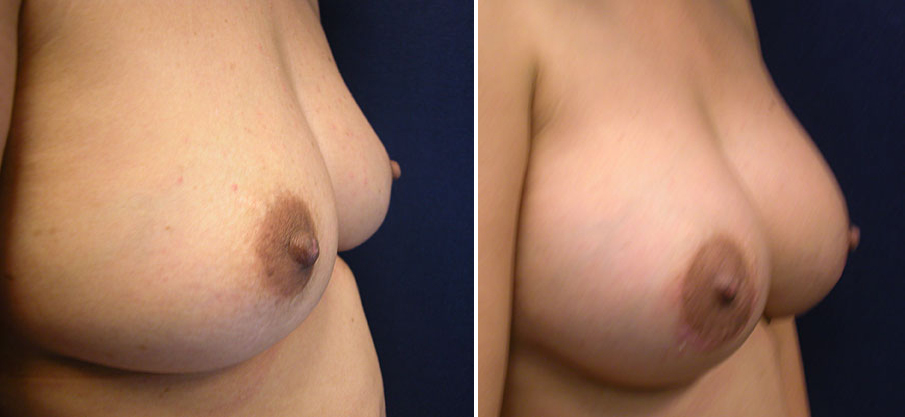
43 year old female patient before and 3 years after bilateral breast lift with implants (240cc round silicone implants). She only has a periareolar scar from the 3 o'clock to the 9 o'clock position. Notice the perkiness achieved with this simple, minimal-scar approach. Dr. Speron also uses an internal breast lift approach to help keep the breast positioning as youthful as possible.
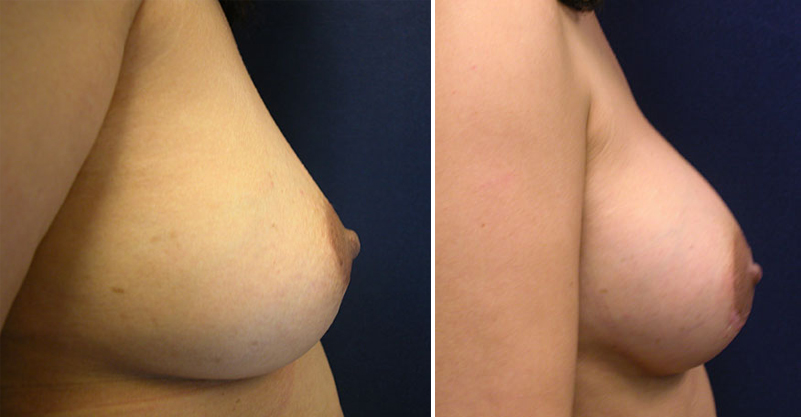
43 year old female patient before and 3 years after bilateral breast lift with implants (240cc round silicone implants). She only has a periareolar scar from the 3 o'clock to the 9 o'clock position. Notice the maintained upper pole fullness and natural appearance achieved with this simple, minimal-scar approach.
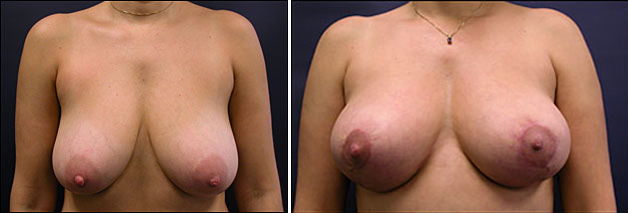
37 year old female patient before and 3 months after bilateral vertical breast lift. She only has a vertical scar. There is no horizontal scar! This is an average result. With the vertical technique, the lift lasts a lot longer in my experience than the older techniques.
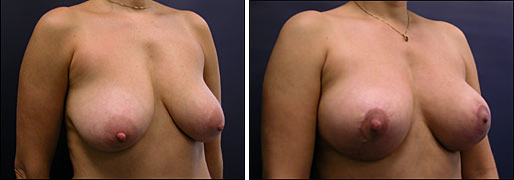
37 year old female patient before and 3 months after bilateral vertical breast lift. Notice the nice breast fullness and tear-drop shape she now has.
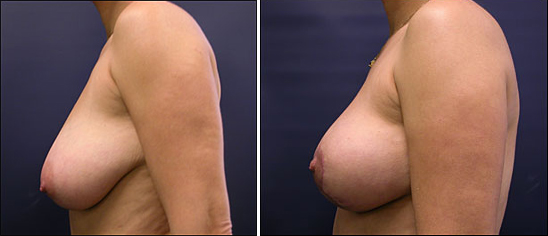
37 year old female patient before and 3 months after bilateral vertical breast lift. Notice the nice correction of her glandular ptosis. Her nipple-areolar position was not that bad before surgery.
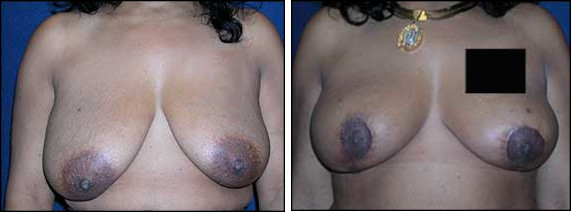
62 year old African American female patient before and 6 months after bilateral vertical breast lift. Notice the natural appearance and improved symmetry with this short-scar approach. This is an average result. No implants are used.
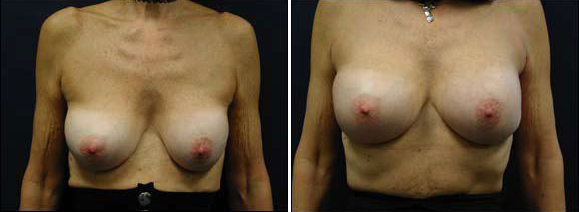
67 year old female patient before and 2 years after bilateral vertical breast lift with implants (removal of 250cc silicone implants and insertion of 450cc high projection silicone implants). She only has a vertical scar. There is no horizontal scar! Patient had a severe contracture of her right breast with rupture of her silicone implant for one year before she saw me. She went to several other plastic surgeon's in the area who were all afraid to deal with her problem. Her right breast is now soft. Notice the nice correction of her preoperative asymmetry.
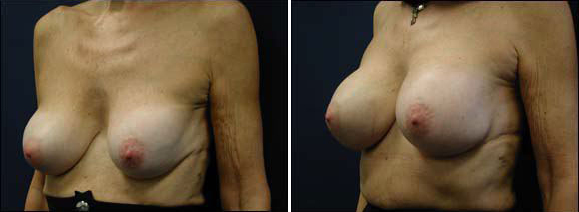
67 year old female patient before and 2 years after bilateral vertical breast lift with implants (removal of 250cc silicone implants and insertion of 450cc high projection silicone implants). She only has a vertical scar. There is no horizontal scar! Notice the natural breast shape, especially for someone her age and with her skin tone.
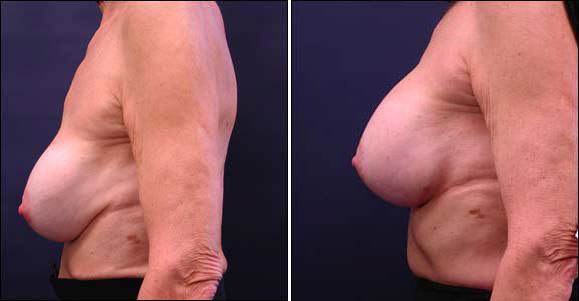
67 year old female patient before and 2 years after bilateral vertical breast lift with implants (removal of 250cc silicone implants and insertion of 450cc high projection silicone implants). She only has a vertical scar. There is no horizontal scar! Notice the well-maintained, natural result. The advantage of the vertical scar technique is that there is no "bottoming out" as is frequently seen with the inverted T approach (of course, as well as a lot less scarring on your breasts).
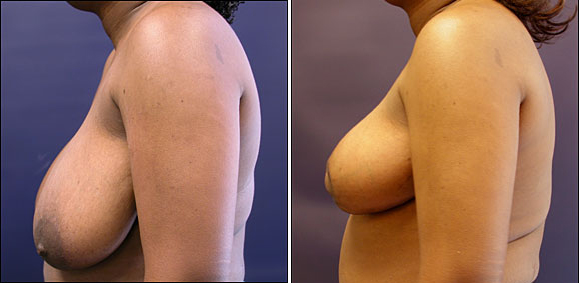
22 year old female patient before and 2 years after bilateral vertical breast reduction (42DDD --> 42C). Notice the maintained projection.
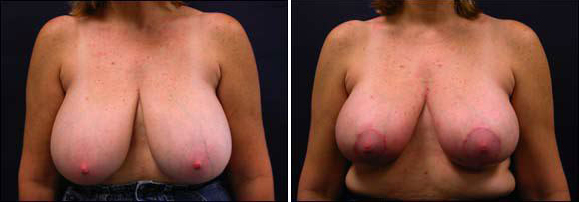
45 year old female patient before and 6 weeks after bilateral vertical breast reduction (36DDD --> 36D). There is no horizontal scar! This was a vertical approach only. Notice how much more of the abdomen is now visible.
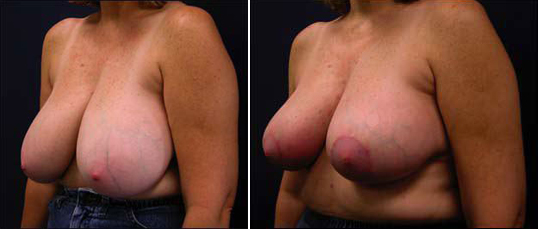
45 year old female patient before and 6 weeks after bilateral vertical breast reduction (36DDD --> 36D). Notice the natural shape.
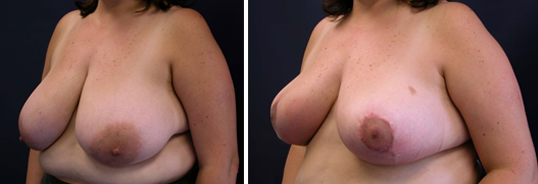
43 year old female patient before and 6 weeks after vertical breast lift with breast reduction (46DDD --> 46C). Patient not only wanted a lifting of her breasts but also a reduction in their size. Notice her natural look. There is no horizontal scar! This was a vertical approach. Patient no longer gets rashes in her breast folds. She feels better about herself.
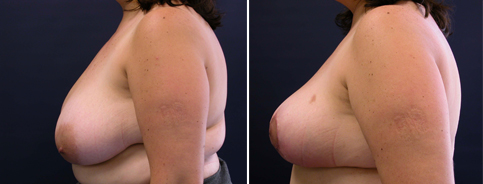
43 year old female patient before and 6 weeks after vertical breast lift with breast reduction (46DDD --> 46C. Notice her natural look. Notice the nice projection.
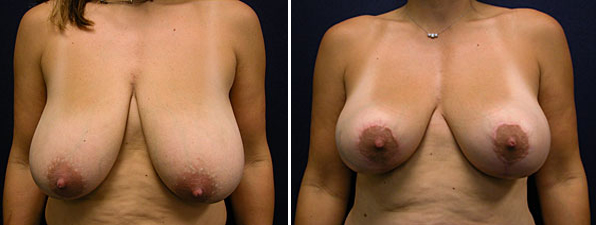
46 year old female patient before and 6 months after bilateral vertical breast reduction (42DDD --> 42C). Notice the improved symmetry with this short-scar approach.
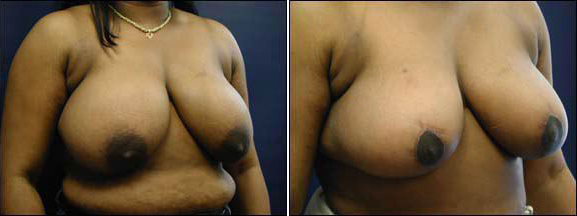
28 year old female patient before and 6 months after bilateral vertical breast reduction (42DDD --> 42C). There is no horizontal scar! This was a vertical approach only. Patient no longer gets infections under her breasts. She feels better about herself. Notice the natural shape.
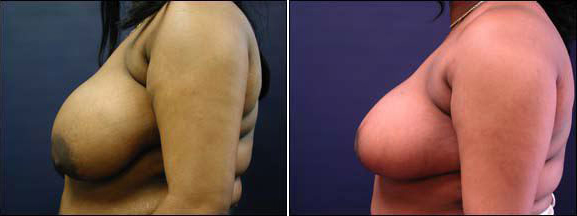
28 year old female patient before and 6 months after bilateral vertical breast reduction (42DDD --> 42C). Notice the nice projection.
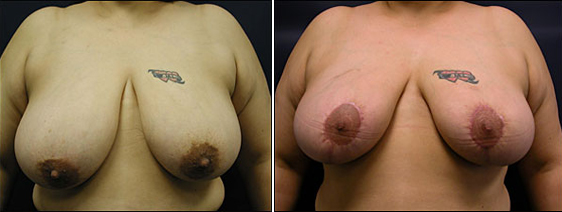
39 year old female patient before and 6 months after bilateral vertical breast reduction (42DD --> 42C). Notice the improved symmetry.
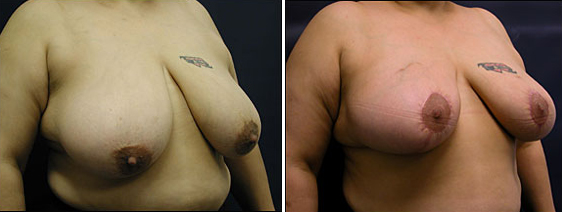
39 year old female patient before and 6 months after bilateral vertical breast reduction (42DD --> 42C). Notice the nice shape.
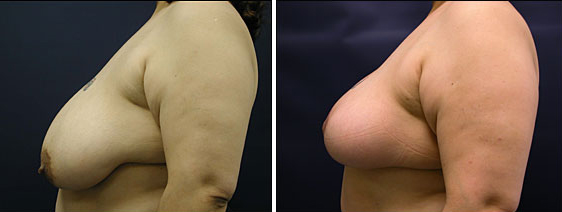
39 year old female patient before and 6 months after bilateral vertical breast reduction (42DD --> 42C). Notice the maintained elevation.
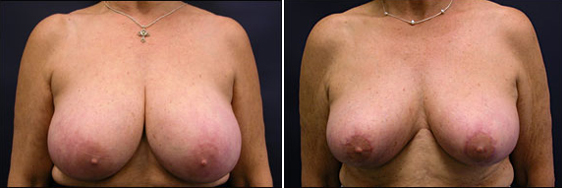
79 year old female patient before and 1 years after bilateral vertical breast reduction surgery (42DD --> 42C). Notice the nice symmetry.
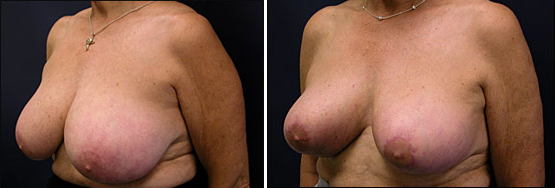
79 year old female patient before and 1 years after bilateral vertical breast reduction surgery (42DD --> 42C). Notice the nice lift.
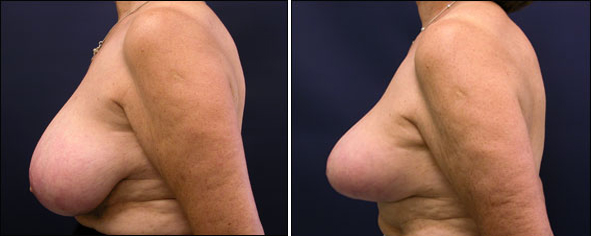
79 year old female patient before and 1 years after bilateral vertical breast reduction surgery (42DD --> 42C). Notice the nice maintained projection.
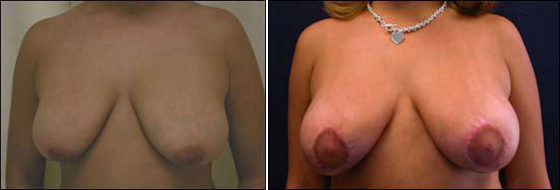
27 year old female patient before and 6 weeks after bilateral breast lift with implants (270cc round saline implants). She only has a periareolar scar. She not only wanted a lift but to also increase her size from B/C --> D, which is why she required breast implants. Notice the wonderful correction of her marked preoperative asymmetry. She is no longer self-conscious.
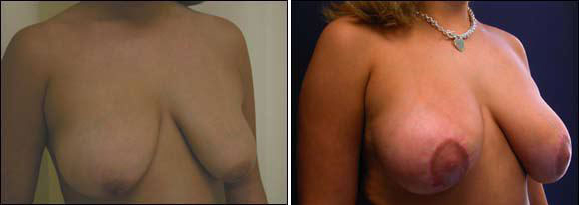
27 year old female patient before and 6 weeks after bilateral breast lift with implants (270cc round saline implants). She only has a periareolar scar. Notice the natural shape.
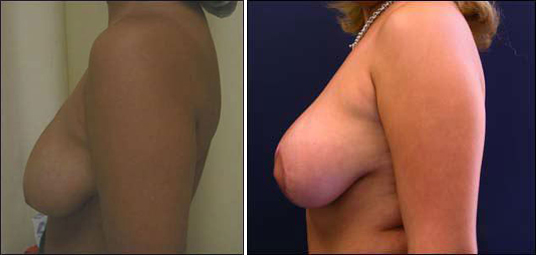
27 year old female patient before and 6 weeks after bilateral breast lift with implants (270cc round saline implants). She only has a periareolar scar. Notice the lifted appearance.
Loss of skin elasticity, gravity and other factors such as weight loss, pregnancy and breast-feeding ultimately affect the shape and firmness of your breasts. Patients who are generally satisfied with the size of their breasts can have a breast lift to raise and firm them, resulting in a more youthful breast contour. Some patients may be unhappy that they have lost a significant amount of breast volume over time. In such cases, implants inserted in conjunction with a breast lift can increase breast size at the same time as the shape and position of the breasts are enhanced.
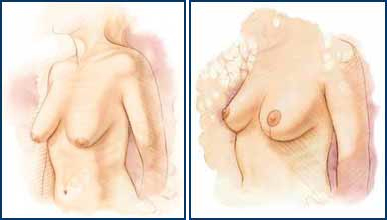
You may be a good candidate for breast lift surgery if you have one or more of the following conditions:
- breasts that are pendulous, but of satisfactory size
- breasts that lack substance or firmness
- nipples and areolas that point downward, especially if they are positioned below the breast crease
Sometimes these conditions may be inherited traits. In certain cases, the breasts may have developed differently so that one breast is firm and well positioned while the other is not. There may be differences in the size of your breasts as well as their shape. Breasts that are large and heavy can be lifted, but the results may not be as long-lasting as when the procedure is done on smaller breasts.
Breast lift surgery can be performed at any age, but plastic surgeons usually recommend waiting until breast development has stopped. Pregnancy and breast-feeding may have significant and unpredictable effects on the size and shape of your breasts. Nevertheless, many women decide to undergo breast lift surgery before having children and feel that they can address any subsequent changes later. Since the milk ducts and nipples are left intact, breast lift surgery usually will not affect your ability to breast-feed; however, you should discuss this with your plastic surgeon.
During the consultation, you will be asked about your desired breast shape and size. Your plastic surgeon will discuss with you how your nipples and areolas will be repositioned. You should mention anything else about your
breasts that you would like to see improved. This will help your surgeon to understand your expectations and determine whether they realistically can be achieved.
How will my plastic surgeon evaluate me for breast lift surgery?
Your plastic surgeon will examine your breasts, taking measurements and perhaps photographs for your medical record. The size and shape of your breasts, the quality of your skin, and the placement of the nipples and areolas will be carefully evaluated.
You should come to the consultation prepared to discuss your medical history. This will include information about any medical conditions, drug allergies, medical treatments you have received, previous surgeries including breast biopsies, and medications that you currently take. It is important for you to provide complete information.
You should tell your plastic surgeon if you plan to lose a significant amount of weight, particularly if you have noticed that your breasts sag or become smaller with weight loss. Your surgeon may recommend that you stabilize
your weight before having surgery.
Will my insurance help cover the cost of surgery?
Breast lift surgery, as an aesthetic (cosmetic) procedure, generally is not covered by insurance.
Under certain circumstances, however, insurance coverage may be available. For example, if a breast reconstruction after mastectomy is performed, the opposite breast may need to be modified for symmetry. Many factors determine your eligibility for coverage, including the specific terms of your insurance policy. A letter of predetermination may be required by your insurance company prior to surgery. Your plastic surgeon or a staff member in your surgeon's office will discuss these matters with you.
Individual factors and personal preferences will determine the specific technique selected to lift your breasts.
Where are the incisions placed?
A common method of lifting the large breasts involves three incisions. One incision is made around the areola. Another runs vertically from the bottom edge of the areola to the crease underneath the breast. The third incision is horizontal beneath the large breast and follows the natural curve of the breast crease.
After the plastic surgeon has removed excess breast skin, the nipple and areola are shifted to a higher position. The areola, which in a sagging large breast may have been stretched, can be reduced in size. Skin that was formerly located above the areola is brought down and together beneath it to reshape the breast.
The nipples and areolas remain attached to underlying mounds of tissue, and this usually allows for the preservation of sensation and the ability to breast-feed.
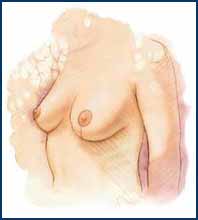
• Incisions following the breast's natural contour define the area of excision and the new location for
the nipple and areola. Skin in the shaded area is removed, and the nipple and areola are moved
to a higher position.
• Skin formerly located above the areola is brought down and together beneath it to reshape the breast.
What are some variations to the common breast lifting technique?
There are many variations to the design of the incisions for breast lift surgery. The size and shape of your breasts, size of your areolas, and extent of sagging are factors that will help your plastic surgeon determine the best technique for you.
In some instances, it may be possible to avoid the horizontal incision beneath the breast. Sometimes a technique may be used that avoids this horizontal incision as well as the vertical incision that runs from the bottom edge of the areola to the breast crease.
If you are a good candidate for a modified technique, your plastic surgeon will discuss this with you.
If you and your plastic surgeon have decided that it is desirable to enlarge your breasts at the same time as they are lifted, this will require insertion of breast implants. If this is an option that you wish to consider, your surgeon will review the necessary information with you and may provide you with a brochure on breast augmentation.
Understanding Risks
Fortunately, significant complications from breast lifts are infrequent. Every year, many thousands of women undergo successful breast lift surgery, experience no major problems and are pleased with the results. Anyone considering
surgery, however, should be aware of both the benefits and risks.
I understand that every surgical procedure has risks, but how will I learn more so that I can make an informed decision?
The subject of risks and potential complications of surgery is best discussed on a personal basis between you and your plastic surgeon, or with a staff member in your surgeon's office.
Some of the potential complications that may be discussed with you include bleeding, infection and reactions to anesthesia. Following a breast lift, sometimes the breasts may not be perfectly symmetrical or the nipple height may vary slightly. Minor adjustments often can be made at a later time. Permanent loss of sensation in the nipples or areas of breast skin may occur rarely. Revisionary surgery may sometimes be helpful in certain instances where incisions may have healed poorly.
You can help to lessen certain risks by following the advice and instructions of your plastic surgeon, both before and after surgery.
The goal of your plastic surgeon and the entire staff is to make your surgical experience as easy and comfortable for you as possible.
How should I prepare for surgery?
Depending on your age, or if you have a history of breast cancer in your family, your plastic surgeon may recommend a baseline mammogram before surgery and another mammographic examination some months after surgery. This will help to detect any future changes in your breast tissue. Following a breast lift (mastopexy), you will still be able to perform breast self-examination. Mastopexy surgery will not increase your risk of developing breast cancer.
If you are a smoker, you will be asked to stop smoking well in advance of surgery. Aspirin and certain anti-inflammatory drugs can cause increased bleeding, so you should avoid taking these medications for a period of time before surgery. Your surgeon will provide you with additional preoperative instructions.
Breast lift surgery is usually performed on an outpatient basis. If this is the case, be sure to arrange for someone to drive you home after surgery and to stay with you at least the first night.
What will the day of surgery be like?
Your mastopexy surgery may be performed in a hospital, free-standing ambulatory facility or office-based surgical suite.
Medications are administered for your comfort during the surgical procedure. Often, a general anesthetic is administered, so that you will be asleep throughout the procedure.
Alternatively, a breast lift may be performed using local anesthesia and intravenous sedation. When surgery is completed, you will be taken into a recovery area where you will continue to be closely monitored. Sometimes, small drain tubes will have been placed in your breasts to help avoid the accumulation of fluids. Gauze or other dressings may be placed on your breasts and covered with an elastic bandage or surgical bra.
You may be permitted to go home after a few hours, unless you and your plastic surgeon have determined that you will stay in the hospital or surgical facility overnight.
How will I look and feel initially?
The day after surgery, you will be encouraged to get out of bed for short periods of time. After several days, you should be able to move about more comfortably. Straining, bending and lifting must be avoided, however, since these activities might cause increased swelling or even bleeding. You may be instructed to sleep on your back to avoid pressure on your breasts.
Any surgical drains will be removed within a few days of surgery, at which time your dressings may also be changed or removed. You may be instructed to wear a support bra for a few weeks, until the swelling and discoloration of your breasts diminish. Generally, stitches will be removed in stages over a period of approximately three weeks, beginning about one week after surgery.
You may notice that you feel less sensation in the nipple and areola areas. This is usually temporary. It may, however, take weeks, months or even more than a year before sensation returns to normal. Your breasts may also require some time to assume a more natural shape. Incisions will initially be red or pink in color. They will remain this way for many months following surgery.
When can I resume my normal activities?
After breast lift surgery, it is often possible to return to work within a week or so, depending on your job. In many instances, you can resume most of your normal activities, including some form of mild exercise, after several weeks. You may continue to experience some mild, periodic discomfort during this time, but such feelings are normal. Severe pain should be reported to your doctor.
Any sexual activity should be avoided for a minimum of one or two weeks, and your plastic surgeon may advise you to wait longer. After that, care must be taken to be extremely gentle with your breasts for at least the next several weeks.
Breast lift surgery will make your breasts firmer and more uplifted. The position of your areolas and nipples will be enhanced, and the size of your areolas will be aesthetically pleasing.
The incisions from your breast surgery will heal and fade over time. It is important to realize, however, that the incision lines will be permanently visible. In some instances, they will eventually be only faint lines.
Certain individuals may have incision lines that are more noticeable. Fortunately, the incisions for your breast lift are in locations easily concealed by clothing, even low-cut necklines.
How long will the results last?
Unless you gain or lose a significant amount of weight or become pregnant, your new breast shape should remain fairly constant. However, gravity and the effects of aging will eventually alter the size and shape of virtually every woman's breasts. If, after a period of years, you again become dissatisfied with the appearance of your breasts, you may choose to undergo a second breast surgery procedure to restore their more youthful contour and appearance.
Post Surgical Care
The results of your breast lift can be maintained with the use of certain clinical skin care products.
Maintaining a Relationship with Your Plastic Surgeon
You will return to your plastic surgeon's office for follow-up care at prescribed intervals, at which time your progress will be evaluated. Once the immediate postoperative follow-up is complete, many surgeons encourage their patients to come back for periodic checkups to observe and discuss the long-term results of surgery.
Please remember that the relationship with your plastic surgeon does not end when you leave the operating room. If you have questions or concerns during your recovery, or need additional information at a later time, you should contact your surgeon.

Dr Speron's Scar Support Treatment combines active ingredients, specifically designed to target scar tissue and help restore the skin’s natural look and feel. On the cellular level, Oxygen, Silicone, Probiotics, Hyaluronic Acid, Peptides and Vitamins promote collagen maturation, increase strength and flexibility, and stimulate circulation. On the surface, this scar treatment provide immediate relief and dramatically reduces itchiness, dryness and irritation. It can be used on all types of scars, traumatic or surgical. It has all the necessary ingredients to make your scar fade away.